Financial Accounting Report: ASX Company Analysis, BAO2202
VerifiedAdded on 2023/04/23
|19
|4142
|208
Report
AI Summary
This report delves into the intricacies of financial accounting, focusing on the recognition and measurement of financial information within two publicly listed ASX companies: Wesfarmers Ltd and Woolworths Ltd. The analysis critically examines accounting standard literature concerning leasing, provisions for income tax expense, benefits and obligations, and intangible assets. It reviews the companies' recent financial statements, comparing their disclosures in these areas against Australian accounting standards. The report highlights that while both companies currently adhere to AASB 117 Leases, they plan to adopt AASB 16 Leases from July 1, 2019. Wesfarmers recognizes intangible assets at their initial cost less accumulated amortization and impairment losses. The report also addresses income tax expense, benefits, and obligations, and provides suggestions for improving accounting standards and reporting practices based on research. The report emphasizes the potential impact of AASB 16 on operating leases within the retail and manufacturing sectors and stresses the importance of understanding the new requirements and communicating changes to stakeholders. It also suggests that the accounting standard should provide for applying the standard to a portfolio of leases.
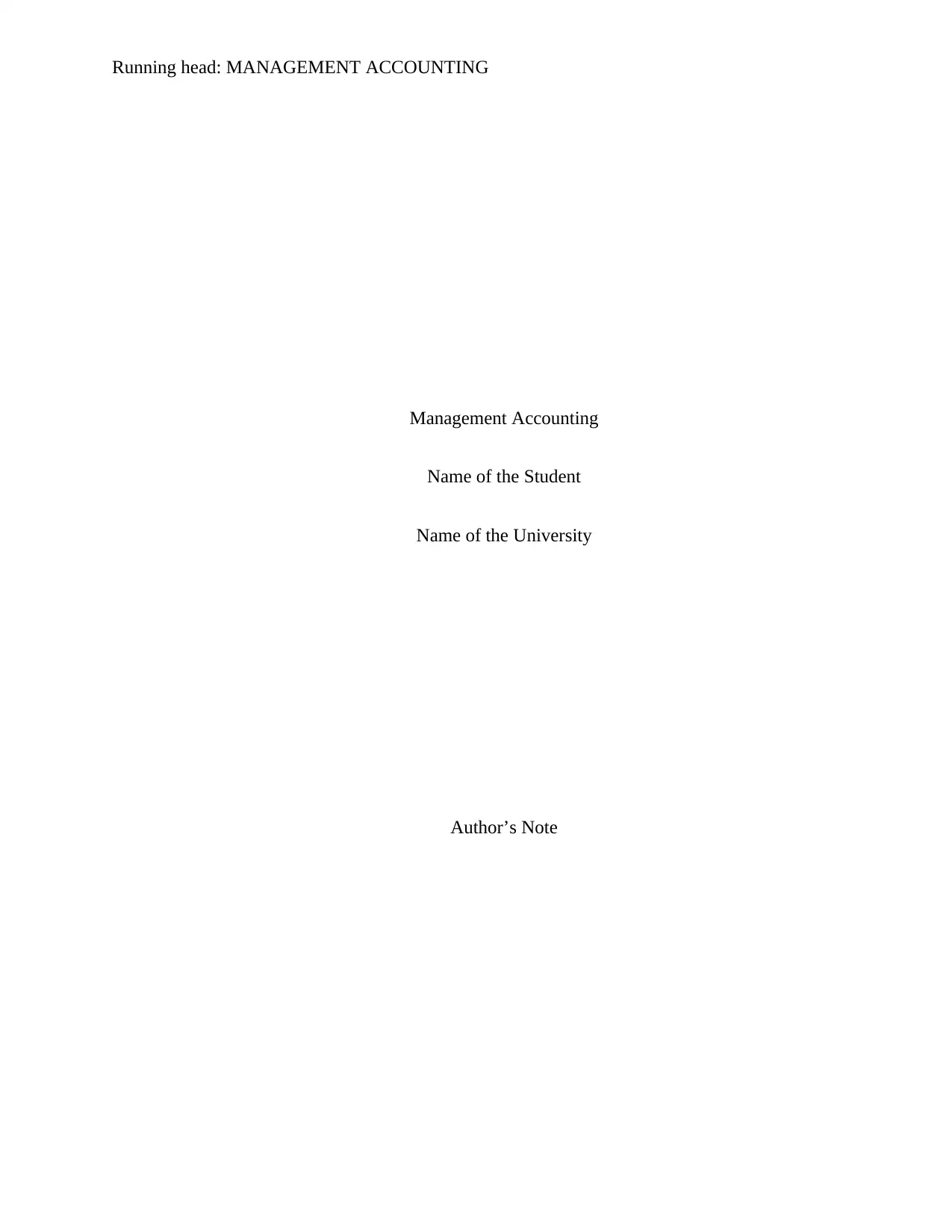
Running head: MANAGEMENT ACCOUNTING
Management Accounting
Name of the Student
Name of the University
Author’s Note
Management Accounting
Name of the Student
Name of the University
Author’s Note
Paraphrase This Document
Need a fresh take? Get an instant paraphrase of this document with our AI Paraphraser

1MANAGEMENT ACCOUNTING
Executive summary
The learnings of the study provide an understanding of issues associated to recognition and
measurement in financial accounting. The in-depth investigation of measuring financial
accounting information is done on two publicly listed ASX companies, Wesfarmers Ltd and
Woolworth Ltd. The financial measurement critically discusses the accounting standard literature
on recognition and measurement requirements for leasing, provisions made for Income tax
expense, benefits and obligations and intangible assets. The other sections of the study have
reviewed the recent financial statement of both companies to analyse and compare the
disclosures made on leasing, provisions for Income tax expense, benefits and obligations and
intangible assets with relevance to Australian accounting standards. The latter part of recognition
and measurement in financial accounting will be provided with suggesting improvement
measures for accounting standard and reporting’s practices followed by the firms based on the
research literature. The findings of the report suggest that despite of following AASB 117 leases,
both the companies have proposed to apply AASB 16 Leases (AASB 16) from 1 July 2019.
Wesfarmers recognises the intangible assets as those assets which are acquired separately and
measured as per initial recognition cost. The recognition criteria of intangible assets for the
company is recognised at “cost less accumulated amortisation and impairment losses”. It can
be further seen that per the amendment AASB 2018-1, Wesfarmers Ltd elucidates the obligation
for IT expenses pertaining to dividend payments to be designated in agreement with the nature of
past profits via which the dividends were derived. On the other hand, Woolworth Ltd recognises
income tax based on deferred tax assets and DTL arising as a temporary difference.
Executive summary
The learnings of the study provide an understanding of issues associated to recognition and
measurement in financial accounting. The in-depth investigation of measuring financial
accounting information is done on two publicly listed ASX companies, Wesfarmers Ltd and
Woolworth Ltd. The financial measurement critically discusses the accounting standard literature
on recognition and measurement requirements for leasing, provisions made for Income tax
expense, benefits and obligations and intangible assets. The other sections of the study have
reviewed the recent financial statement of both companies to analyse and compare the
disclosures made on leasing, provisions for Income tax expense, benefits and obligations and
intangible assets with relevance to Australian accounting standards. The latter part of recognition
and measurement in financial accounting will be provided with suggesting improvement
measures for accounting standard and reporting’s practices followed by the firms based on the
research literature. The findings of the report suggest that despite of following AASB 117 leases,
both the companies have proposed to apply AASB 16 Leases (AASB 16) from 1 July 2019.
Wesfarmers recognises the intangible assets as those assets which are acquired separately and
measured as per initial recognition cost. The recognition criteria of intangible assets for the
company is recognised at “cost less accumulated amortisation and impairment losses”. It can
be further seen that per the amendment AASB 2018-1, Wesfarmers Ltd elucidates the obligation
for IT expenses pertaining to dividend payments to be designated in agreement with the nature of
past profits via which the dividends were derived. On the other hand, Woolworth Ltd recognises
income tax based on deferred tax assets and DTL arising as a temporary difference.
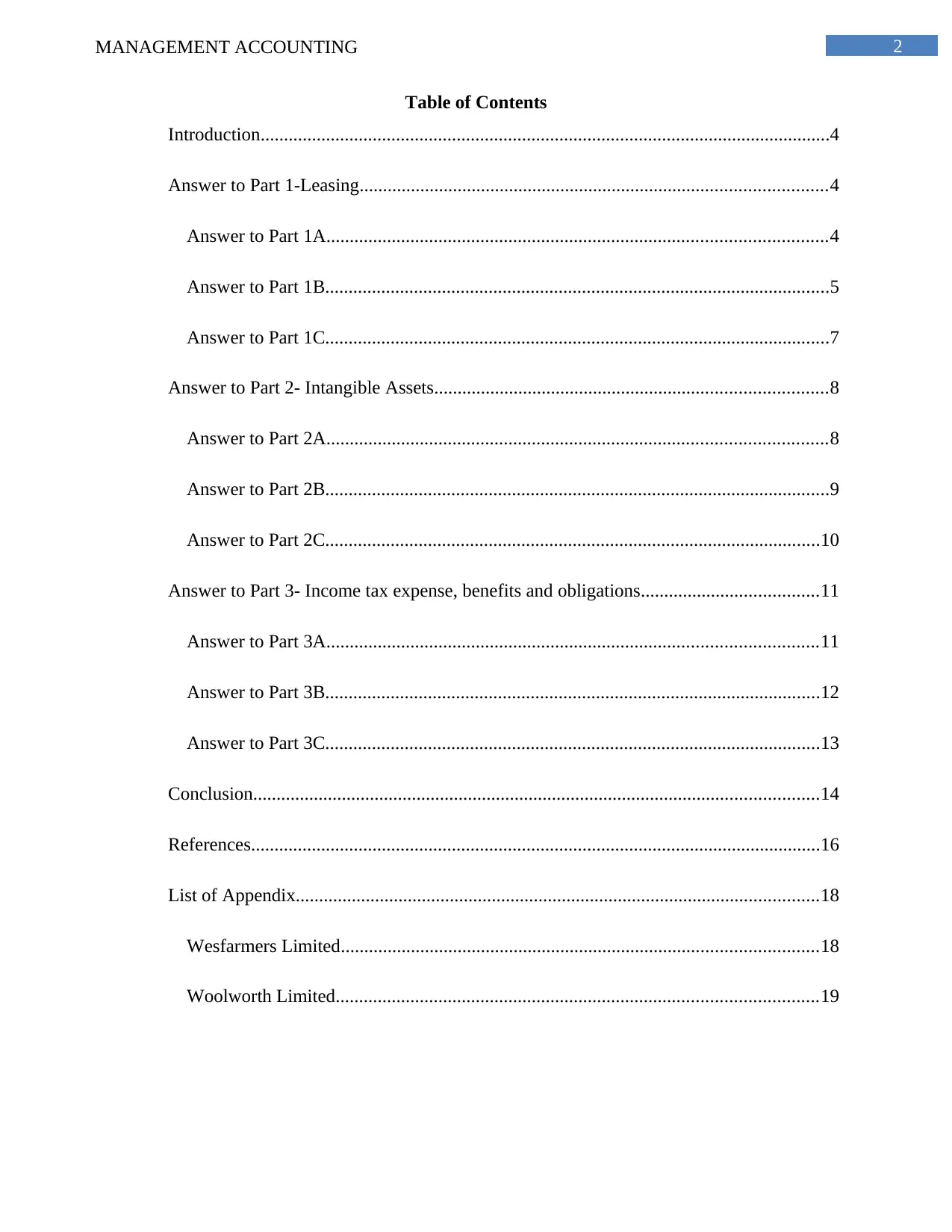
2MANAGEMENT ACCOUNTING
Table of Contents
Introduction..........................................................................................................................4
Answer to Part 1-Leasing....................................................................................................4
Answer to Part 1A...........................................................................................................4
Answer to Part 1B............................................................................................................5
Answer to Part 1C............................................................................................................7
Answer to Part 2- Intangible Assets....................................................................................8
Answer to Part 2A...........................................................................................................8
Answer to Part 2B............................................................................................................9
Answer to Part 2C..........................................................................................................10
Answer to Part 3- Income tax expense, benefits and obligations......................................11
Answer to Part 3A.........................................................................................................11
Answer to Part 3B..........................................................................................................12
Answer to Part 3C..........................................................................................................13
Conclusion.........................................................................................................................14
References..........................................................................................................................16
List of Appendix................................................................................................................18
Wesfarmers Limited......................................................................................................18
Woolworth Limited.......................................................................................................19
Table of Contents
Introduction..........................................................................................................................4
Answer to Part 1-Leasing....................................................................................................4
Answer to Part 1A...........................................................................................................4
Answer to Part 1B............................................................................................................5
Answer to Part 1C............................................................................................................7
Answer to Part 2- Intangible Assets....................................................................................8
Answer to Part 2A...........................................................................................................8
Answer to Part 2B............................................................................................................9
Answer to Part 2C..........................................................................................................10
Answer to Part 3- Income tax expense, benefits and obligations......................................11
Answer to Part 3A.........................................................................................................11
Answer to Part 3B..........................................................................................................12
Answer to Part 3C..........................................................................................................13
Conclusion.........................................................................................................................14
References..........................................................................................................................16
List of Appendix................................................................................................................18
Wesfarmers Limited......................................................................................................18
Woolworth Limited.......................................................................................................19
⊘ This is a preview!⊘
Do you want full access?
Subscribe today to unlock all pages.

Trusted by 1+ million students worldwide

3MANAGEMENT ACCOUNTING
Introduction
The discourse of the study is aimed at providing an understanding of issues associated to
recognition and measurement in financial accounting. The vivid investigation of various
parameters of measuring financial accounting information is done on two publicly listed ASX
companies namely Wesfarmers Ltd and Woolworth Ltd. The financial measurement has been
considered by critically discussing the accounting standard literature on recognition and
measurement requirements for leasing, provisions made for Income tax expense, benefits and
obligations and intangible assets. The report will also review the recent financial statement of
both companies to analyse and compare the disclosures made on leasing, provisions for Income
tax expense, benefits and obligations and intangible assets with relevance to Australian
accounting standards. The latter part of recognition and measurement in financial accounting will
be provided with suggesting improvement measures for accounting standard and reporting’s
practices followed by the firms based on the research literature.
Answer to Part 1-Leasing
Answer to Part 1A
Australian accounting standard recognises lease as any contract whereby lessor conveys
to the lessee the “right to use an asset” for a certain period of time in return for a single payment
or series of payment. A finance lease is associated to substantial transferring of risk and reward
related to the proprietorship of an asset. On the other hand, an operating lease can be transferred
to another incidental ownership. A non-cancellable lease is any lease which can be cancelled
with permission of lesser, presence of remote contingency or in case lessee agrees to enter into a
new lease contract having equivalent asset with same lessor (Aasb.gov.au 2019). Presently, all
Australian entities adhere to AASB 117 Leases which is issued by IASB.
Introduction
The discourse of the study is aimed at providing an understanding of issues associated to
recognition and measurement in financial accounting. The vivid investigation of various
parameters of measuring financial accounting information is done on two publicly listed ASX
companies namely Wesfarmers Ltd and Woolworth Ltd. The financial measurement has been
considered by critically discussing the accounting standard literature on recognition and
measurement requirements for leasing, provisions made for Income tax expense, benefits and
obligations and intangible assets. The report will also review the recent financial statement of
both companies to analyse and compare the disclosures made on leasing, provisions for Income
tax expense, benefits and obligations and intangible assets with relevance to Australian
accounting standards. The latter part of recognition and measurement in financial accounting will
be provided with suggesting improvement measures for accounting standard and reporting’s
practices followed by the firms based on the research literature.
Answer to Part 1-Leasing
Answer to Part 1A
Australian accounting standard recognises lease as any contract whereby lessor conveys
to the lessee the “right to use an asset” for a certain period of time in return for a single payment
or series of payment. A finance lease is associated to substantial transferring of risk and reward
related to the proprietorship of an asset. On the other hand, an operating lease can be transferred
to another incidental ownership. A non-cancellable lease is any lease which can be cancelled
with permission of lesser, presence of remote contingency or in case lessee agrees to enter into a
new lease contract having equivalent asset with same lessor (Aasb.gov.au 2019). Presently, all
Australian entities adhere to AASB 117 Leases which is issued by IASB.
Paraphrase This Document
Need a fresh take? Get an instant paraphrase of this document with our AI Paraphraser
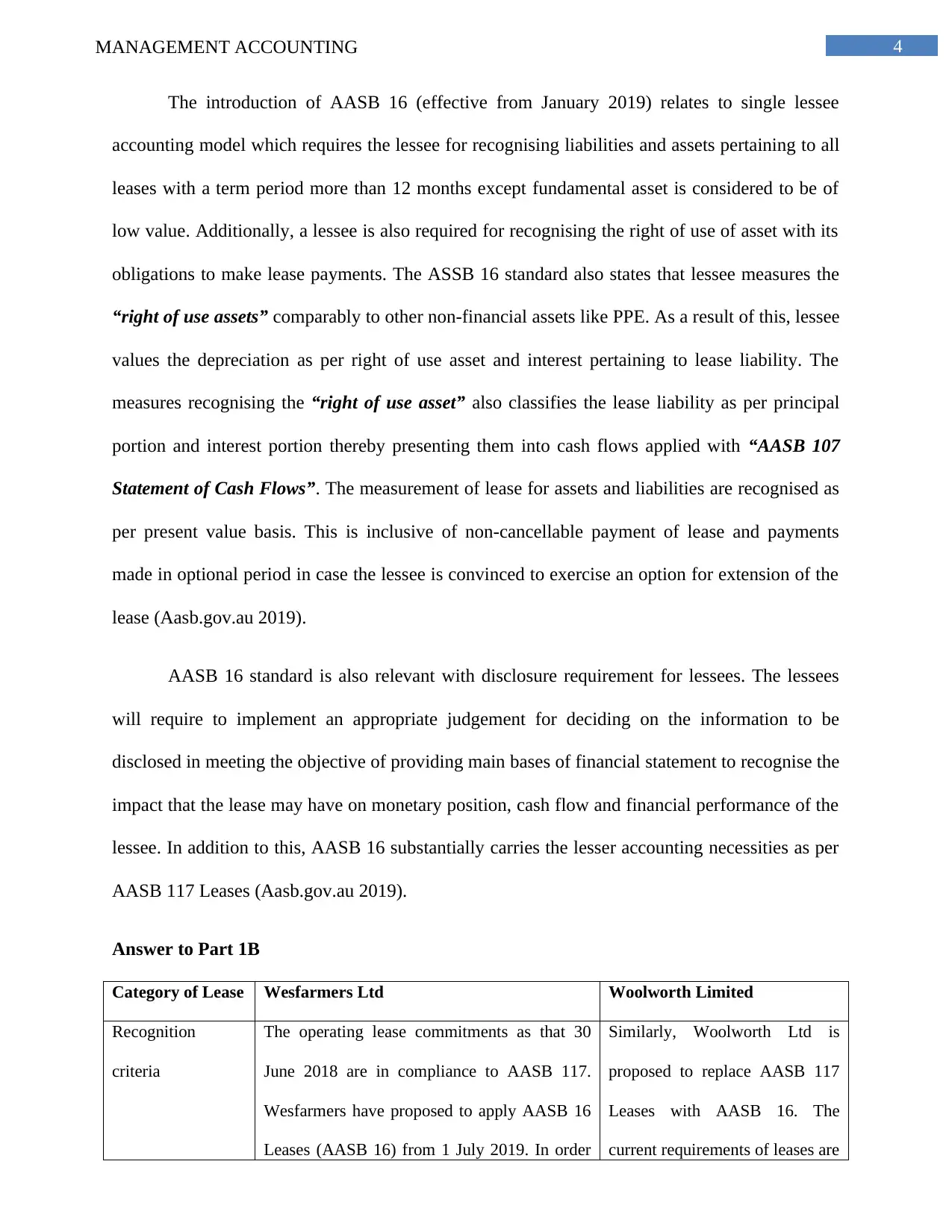
4MANAGEMENT ACCOUNTING
The introduction of AASB 16 (effective from January 2019) relates to single lessee
accounting model which requires the lessee for recognising liabilities and assets pertaining to all
leases with a term period more than 12 months except fundamental asset is considered to be of
low value. Additionally, a lessee is also required for recognising the right of use of asset with its
obligations to make lease payments. The ASSB 16 standard also states that lessee measures the
“right of use assets” comparably to other non-financial assets like PPE. As a result of this, lessee
values the depreciation as per right of use asset and interest pertaining to lease liability. The
measures recognising the “right of use asset” also classifies the lease liability as per principal
portion and interest portion thereby presenting them into cash flows applied with “AASB 107
Statement of Cash Flows”. The measurement of lease for assets and liabilities are recognised as
per present value basis. This is inclusive of non-cancellable payment of lease and payments
made in optional period in case the lessee is convinced to exercise an option for extension of the
lease (Aasb.gov.au 2019).
AASB 16 standard is also relevant with disclosure requirement for lessees. The lessees
will require to implement an appropriate judgement for deciding on the information to be
disclosed in meeting the objective of providing main bases of financial statement to recognise the
impact that the lease may have on monetary position, cash flow and financial performance of the
lessee. In addition to this, AASB 16 substantially carries the lesser accounting necessities as per
AASB 117 Leases (Aasb.gov.au 2019).
Answer to Part 1B
Category of Lease Wesfarmers Ltd Woolworth Limited
Recognition
criteria
The operating lease commitments as that 30
June 2018 are in compliance to AASB 117.
Wesfarmers have proposed to apply AASB 16
Leases (AASB 16) from 1 July 2019. In order
Similarly, Woolworth Ltd is
proposed to replace AASB 117
Leases with AASB 16. The
current requirements of leases are
The introduction of AASB 16 (effective from January 2019) relates to single lessee
accounting model which requires the lessee for recognising liabilities and assets pertaining to all
leases with a term period more than 12 months except fundamental asset is considered to be of
low value. Additionally, a lessee is also required for recognising the right of use of asset with its
obligations to make lease payments. The ASSB 16 standard also states that lessee measures the
“right of use assets” comparably to other non-financial assets like PPE. As a result of this, lessee
values the depreciation as per right of use asset and interest pertaining to lease liability. The
measures recognising the “right of use asset” also classifies the lease liability as per principal
portion and interest portion thereby presenting them into cash flows applied with “AASB 107
Statement of Cash Flows”. The measurement of lease for assets and liabilities are recognised as
per present value basis. This is inclusive of non-cancellable payment of lease and payments
made in optional period in case the lessee is convinced to exercise an option for extension of the
lease (Aasb.gov.au 2019).
AASB 16 standard is also relevant with disclosure requirement for lessees. The lessees
will require to implement an appropriate judgement for deciding on the information to be
disclosed in meeting the objective of providing main bases of financial statement to recognise the
impact that the lease may have on monetary position, cash flow and financial performance of the
lessee. In addition to this, AASB 16 substantially carries the lesser accounting necessities as per
AASB 117 Leases (Aasb.gov.au 2019).
Answer to Part 1B
Category of Lease Wesfarmers Ltd Woolworth Limited
Recognition
criteria
The operating lease commitments as that 30
June 2018 are in compliance to AASB 117.
Wesfarmers have proposed to apply AASB 16
Leases (AASB 16) from 1 July 2019. In order
Similarly, Woolworth Ltd is
proposed to replace AASB 117
Leases with AASB 16. The
current requirements of leases are

5MANAGEMENT ACCOUNTING
to manage this transition, the group has
introduced new system for ongoing compliance
with the standard. It has further determined the
appropriate discount rate for evaluating the
present value of future lease on transition.
Additionally, the judgements as per assessment
of non-lease components are excluded from the
right of use asset (Wesfarmers.com.au. 2019).
based on categorisation of
finance leases recognised as per
concert later statement of
financial position or operating
leases. Following the lease
recognition as per AASB 16, the
group full be able to account for
the operating leases as a result of
“right of use asset and
associated lease liability”
considered as per consolidated
statement of financial position
(Woolworthsgroup.com.au.
2019).
Finance lease There has been no disclosure made by the
company pertaining to finance lease.
The group has applied “AASB
2016-2 Amendments to
Australian Accounting
Standards – Disclosure
Initiative: Amendments to
AASB 107” for finance lease.
Operating lease The company has declared operating lease
commitments as an expense in the income
statement on as “straight-line basis” for the
lease term. On the other hand, the operating
lease incentives are considered as liability over
the lease term (Wesfarmers.com.au. 2019).
Similarly, operating lease
outgoings are recognised as per
“straight-line basis” over the
term of lease. Additionally, the
fixed-rate interests to lease rental
payments excluded against
index-based rental increases are
to manage this transition, the group has
introduced new system for ongoing compliance
with the standard. It has further determined the
appropriate discount rate for evaluating the
present value of future lease on transition.
Additionally, the judgements as per assessment
of non-lease components are excluded from the
right of use asset (Wesfarmers.com.au. 2019).
based on categorisation of
finance leases recognised as per
concert later statement of
financial position or operating
leases. Following the lease
recognition as per AASB 16, the
group full be able to account for
the operating leases as a result of
“right of use asset and
associated lease liability”
considered as per consolidated
statement of financial position
(Woolworthsgroup.com.au.
2019).
Finance lease There has been no disclosure made by the
company pertaining to finance lease.
The group has applied “AASB
2016-2 Amendments to
Australian Accounting
Standards – Disclosure
Initiative: Amendments to
AASB 107” for finance lease.
Operating lease The company has declared operating lease
commitments as an expense in the income
statement on as “straight-line basis” for the
lease term. On the other hand, the operating
lease incentives are considered as liability over
the lease term (Wesfarmers.com.au. 2019).
Similarly, operating lease
outgoings are recognised as per
“straight-line basis” over the
term of lease. Additionally, the
fixed-rate interests to lease rental
payments excluded against
index-based rental increases are
⊘ This is a preview!⊘
Do you want full access?
Subscribe today to unlock all pages.

Trusted by 1+ million students worldwide
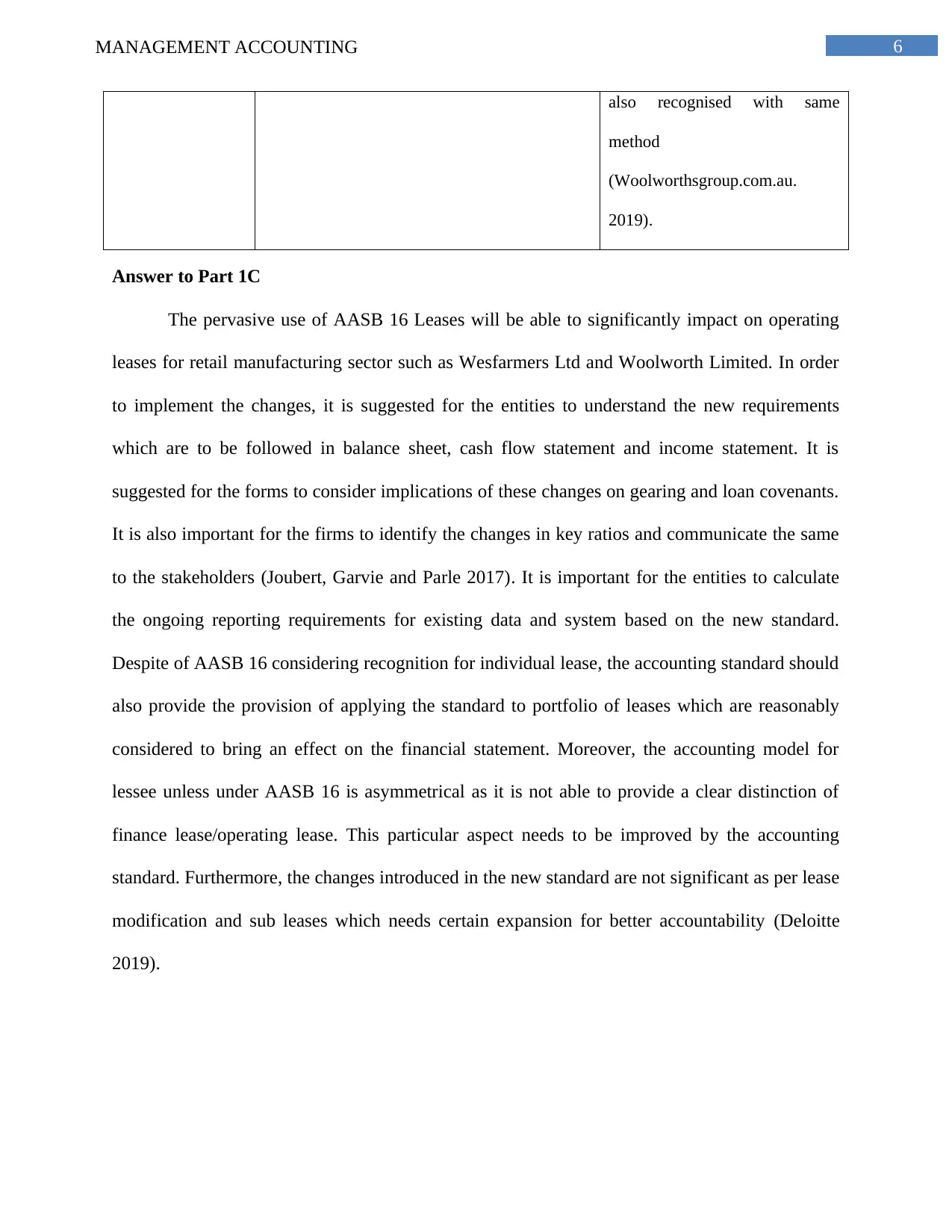
6MANAGEMENT ACCOUNTING
also recognised with same
method
(Woolworthsgroup.com.au.
2019).
Answer to Part 1C
The pervasive use of AASB 16 Leases will be able to significantly impact on operating
leases for retail manufacturing sector such as Wesfarmers Ltd and Woolworth Limited. In order
to implement the changes, it is suggested for the entities to understand the new requirements
which are to be followed in balance sheet, cash flow statement and income statement. It is
suggested for the forms to consider implications of these changes on gearing and loan covenants.
It is also important for the firms to identify the changes in key ratios and communicate the same
to the stakeholders (Joubert, Garvie and Parle 2017). It is important for the entities to calculate
the ongoing reporting requirements for existing data and system based on the new standard.
Despite of AASB 16 considering recognition for individual lease, the accounting standard should
also provide the provision of applying the standard to portfolio of leases which are reasonably
considered to bring an effect on the financial statement. Moreover, the accounting model for
lessee unless under AASB 16 is asymmetrical as it is not able to provide a clear distinction of
finance lease/operating lease. This particular aspect needs to be improved by the accounting
standard. Furthermore, the changes introduced in the new standard are not significant as per lease
modification and sub leases which needs certain expansion for better accountability (Deloitte
2019).
also recognised with same
method
(Woolworthsgroup.com.au.
2019).
Answer to Part 1C
The pervasive use of AASB 16 Leases will be able to significantly impact on operating
leases for retail manufacturing sector such as Wesfarmers Ltd and Woolworth Limited. In order
to implement the changes, it is suggested for the entities to understand the new requirements
which are to be followed in balance sheet, cash flow statement and income statement. It is
suggested for the forms to consider implications of these changes on gearing and loan covenants.
It is also important for the firms to identify the changes in key ratios and communicate the same
to the stakeholders (Joubert, Garvie and Parle 2017). It is important for the entities to calculate
the ongoing reporting requirements for existing data and system based on the new standard.
Despite of AASB 16 considering recognition for individual lease, the accounting standard should
also provide the provision of applying the standard to portfolio of leases which are reasonably
considered to bring an effect on the financial statement. Moreover, the accounting model for
lessee unless under AASB 16 is asymmetrical as it is not able to provide a clear distinction of
finance lease/operating lease. This particular aspect needs to be improved by the accounting
standard. Furthermore, the changes introduced in the new standard are not significant as per lease
modification and sub leases which needs certain expansion for better accountability (Deloitte
2019).
Paraphrase This Document
Need a fresh take? Get an instant paraphrase of this document with our AI Paraphraser
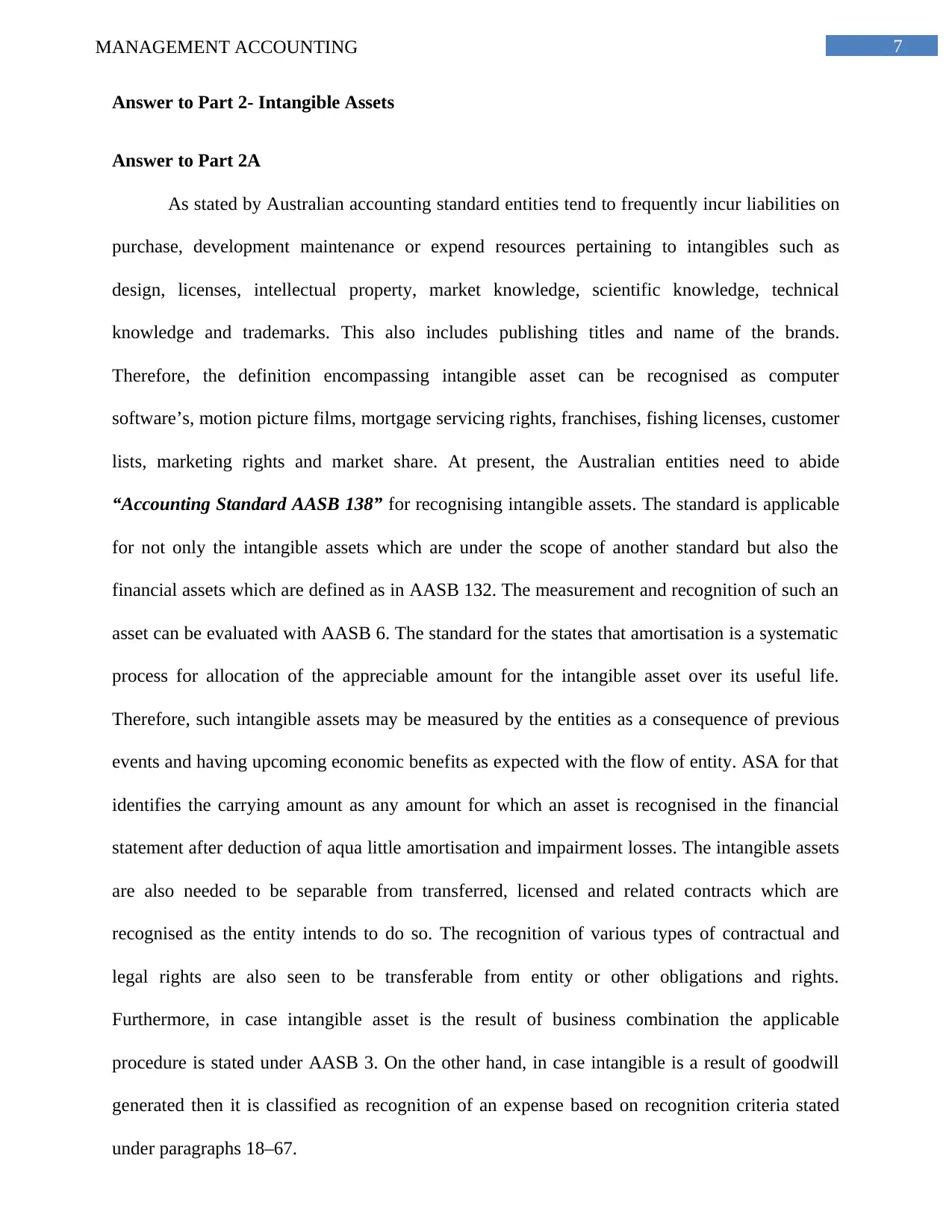
7MANAGEMENT ACCOUNTING
Answer to Part 2- Intangible Assets
Answer to Part 2A
As stated by Australian accounting standard entities tend to frequently incur liabilities on
purchase, development maintenance or expend resources pertaining to intangibles such as
design, licenses, intellectual property, market knowledge, scientific knowledge, technical
knowledge and trademarks. This also includes publishing titles and name of the brands.
Therefore, the definition encompassing intangible asset can be recognised as computer
software’s, motion picture films, mortgage servicing rights, franchises, fishing licenses, customer
lists, marketing rights and market share. At present, the Australian entities need to abide
“Accounting Standard AASB 138” for recognising intangible assets. The standard is applicable
for not only the intangible assets which are under the scope of another standard but also the
financial assets which are defined as in AASB 132. The measurement and recognition of such an
asset can be evaluated with AASB 6. The standard for the states that amortisation is a systematic
process for allocation of the appreciable amount for the intangible asset over its useful life.
Therefore, such intangible assets may be measured by the entities as a consequence of previous
events and having upcoming economic benefits as expected with the flow of entity. ASA for that
identifies the carrying amount as any amount for which an asset is recognised in the financial
statement after deduction of aqua little amortisation and impairment losses. The intangible assets
are also needed to be separable from transferred, licensed and related contracts which are
recognised as the entity intends to do so. The recognition of various types of contractual and
legal rights are also seen to be transferable from entity or other obligations and rights.
Furthermore, in case intangible asset is the result of business combination the applicable
procedure is stated under AASB 3. On the other hand, in case intangible is a result of goodwill
generated then it is classified as recognition of an expense based on recognition criteria stated
under paragraphs 18–67.
Answer to Part 2- Intangible Assets
Answer to Part 2A
As stated by Australian accounting standard entities tend to frequently incur liabilities on
purchase, development maintenance or expend resources pertaining to intangibles such as
design, licenses, intellectual property, market knowledge, scientific knowledge, technical
knowledge and trademarks. This also includes publishing titles and name of the brands.
Therefore, the definition encompassing intangible asset can be recognised as computer
software’s, motion picture films, mortgage servicing rights, franchises, fishing licenses, customer
lists, marketing rights and market share. At present, the Australian entities need to abide
“Accounting Standard AASB 138” for recognising intangible assets. The standard is applicable
for not only the intangible assets which are under the scope of another standard but also the
financial assets which are defined as in AASB 132. The measurement and recognition of such an
asset can be evaluated with AASB 6. The standard for the states that amortisation is a systematic
process for allocation of the appreciable amount for the intangible asset over its useful life.
Therefore, such intangible assets may be measured by the entities as a consequence of previous
events and having upcoming economic benefits as expected with the flow of entity. ASA for that
identifies the carrying amount as any amount for which an asset is recognised in the financial
statement after deduction of aqua little amortisation and impairment losses. The intangible assets
are also needed to be separable from transferred, licensed and related contracts which are
recognised as the entity intends to do so. The recognition of various types of contractual and
legal rights are also seen to be transferable from entity or other obligations and rights.
Furthermore, in case intangible asset is the result of business combination the applicable
procedure is stated under AASB 3. On the other hand, in case intangible is a result of goodwill
generated then it is classified as recognition of an expense based on recognition criteria stated
under paragraphs 18–67.
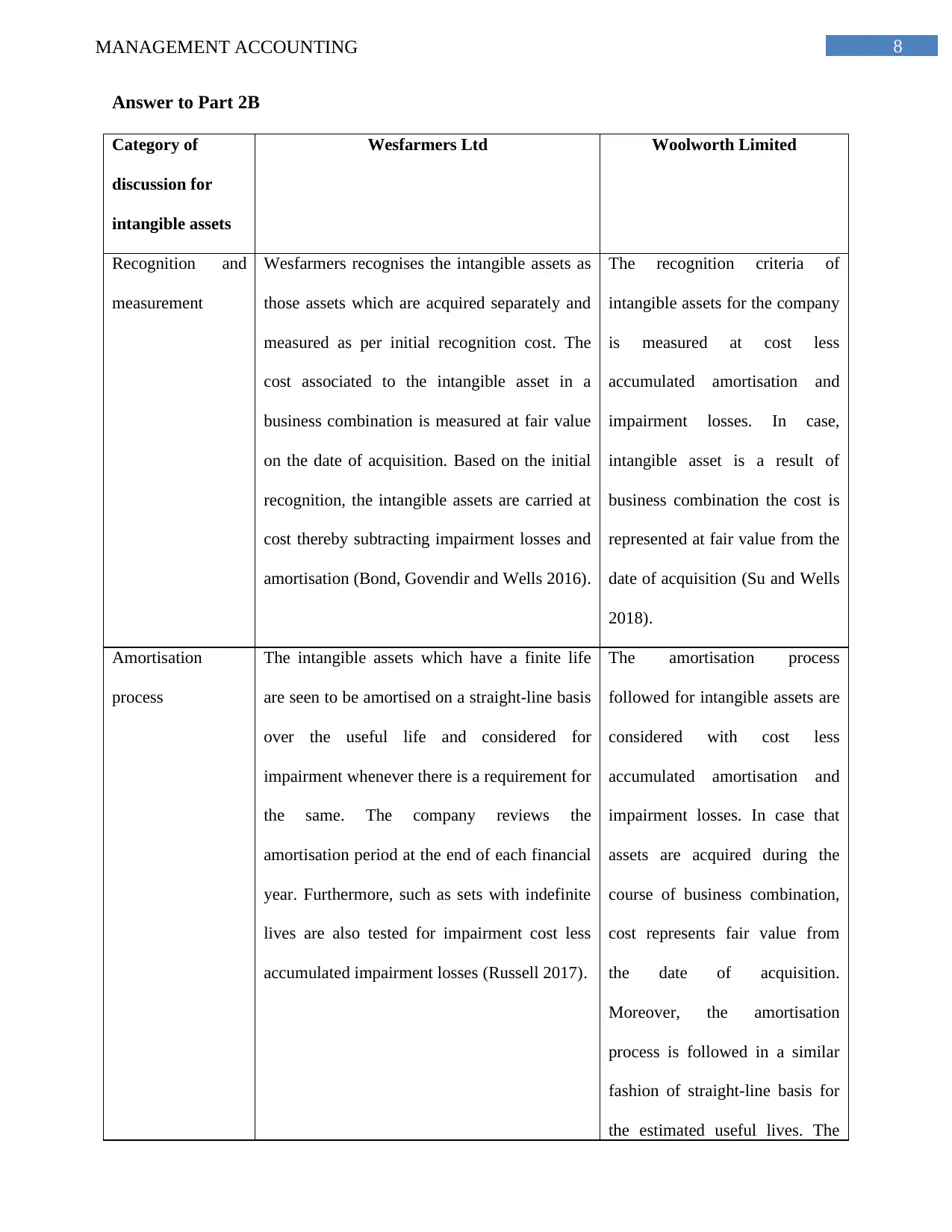
8MANAGEMENT ACCOUNTING
Answer to Part 2B
Category of
discussion for
intangible assets
Wesfarmers Ltd Woolworth Limited
Recognition and
measurement
Wesfarmers recognises the intangible assets as
those assets which are acquired separately and
measured as per initial recognition cost. The
cost associated to the intangible asset in a
business combination is measured at fair value
on the date of acquisition. Based on the initial
recognition, the intangible assets are carried at
cost thereby subtracting impairment losses and
amortisation (Bond, Govendir and Wells 2016).
The recognition criteria of
intangible assets for the company
is measured at cost less
accumulated amortisation and
impairment losses. In case,
intangible asset is a result of
business combination the cost is
represented at fair value from the
date of acquisition (Su and Wells
2018).
Amortisation
process
The intangible assets which have a finite life
are seen to be amortised on a straight-line basis
over the useful life and considered for
impairment whenever there is a requirement for
the same. The company reviews the
amortisation period at the end of each financial
year. Furthermore, such as sets with indefinite
lives are also tested for impairment cost less
accumulated impairment losses (Russell 2017).
The amortisation process
followed for intangible assets are
considered with cost less
accumulated amortisation and
impairment losses. In case that
assets are acquired during the
course of business combination,
cost represents fair value from
the date of acquisition.
Moreover, the amortisation
process is followed in a similar
fashion of straight-line basis for
the estimated useful lives. The
Answer to Part 2B
Category of
discussion for
intangible assets
Wesfarmers Ltd Woolworth Limited
Recognition and
measurement
Wesfarmers recognises the intangible assets as
those assets which are acquired separately and
measured as per initial recognition cost. The
cost associated to the intangible asset in a
business combination is measured at fair value
on the date of acquisition. Based on the initial
recognition, the intangible assets are carried at
cost thereby subtracting impairment losses and
amortisation (Bond, Govendir and Wells 2016).
The recognition criteria of
intangible assets for the company
is measured at cost less
accumulated amortisation and
impairment losses. In case,
intangible asset is a result of
business combination the cost is
represented at fair value from the
date of acquisition (Su and Wells
2018).
Amortisation
process
The intangible assets which have a finite life
are seen to be amortised on a straight-line basis
over the useful life and considered for
impairment whenever there is a requirement for
the same. The company reviews the
amortisation period at the end of each financial
year. Furthermore, such as sets with indefinite
lives are also tested for impairment cost less
accumulated impairment losses (Russell 2017).
The amortisation process
followed for intangible assets are
considered with cost less
accumulated amortisation and
impairment losses. In case that
assets are acquired during the
course of business combination,
cost represents fair value from
the date of acquisition.
Moreover, the amortisation
process is followed in a similar
fashion of straight-line basis for
the estimated useful lives. The
⊘ This is a preview!⊘
Do you want full access?
Subscribe today to unlock all pages.

Trusted by 1+ million students worldwide
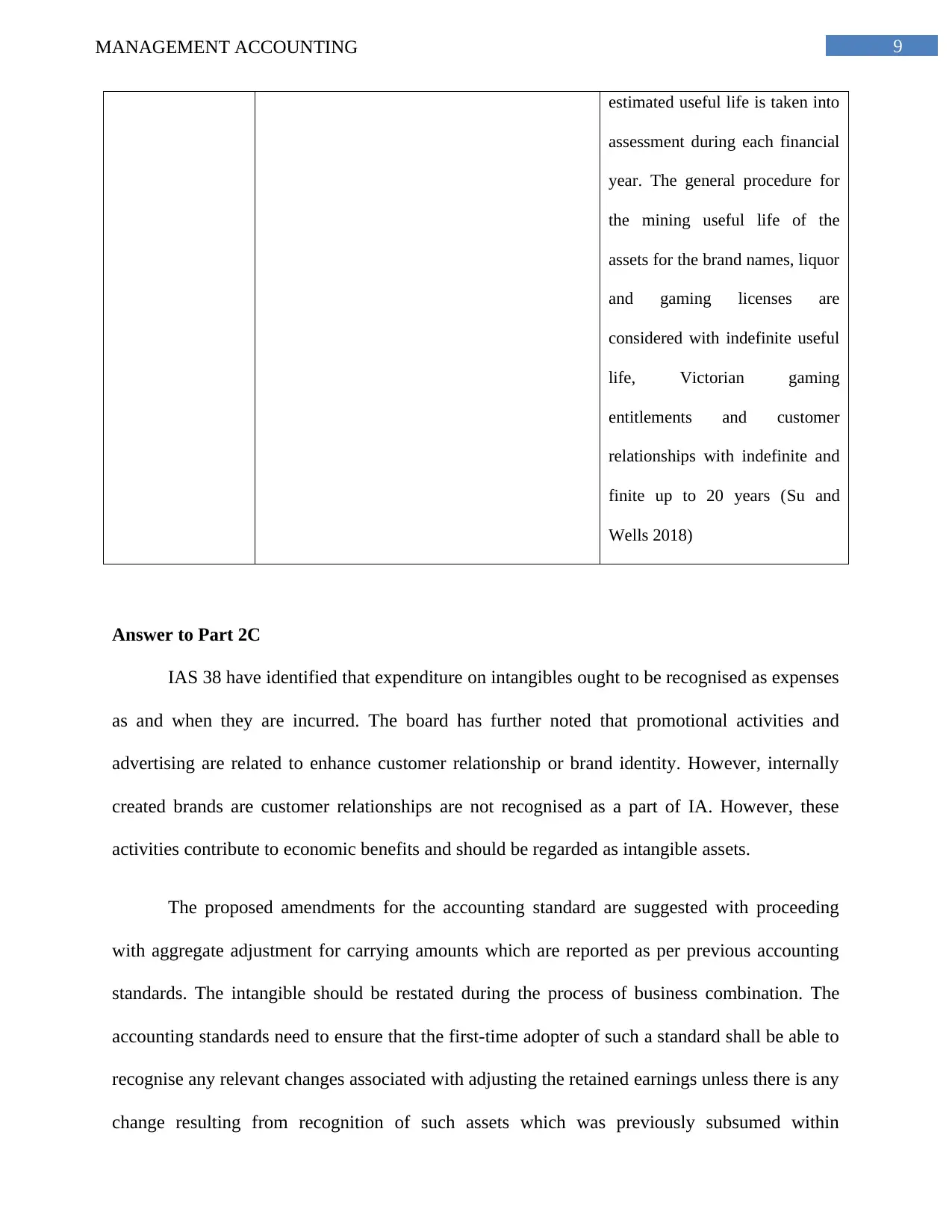
9MANAGEMENT ACCOUNTING
estimated useful life is taken into
assessment during each financial
year. The general procedure for
the mining useful life of the
assets for the brand names, liquor
and gaming licenses are
considered with indefinite useful
life, Victorian gaming
entitlements and customer
relationships with indefinite and
finite up to 20 years (Su and
Wells 2018)
Answer to Part 2C
IAS 38 have identified that expenditure on intangibles ought to be recognised as expenses
as and when they are incurred. The board has further noted that promotional activities and
advertising are related to enhance customer relationship or brand identity. However, internally
created brands are customer relationships are not recognised as a part of IA. However, these
activities contribute to economic benefits and should be regarded as intangible assets.
The proposed amendments for the accounting standard are suggested with proceeding
with aggregate adjustment for carrying amounts which are reported as per previous accounting
standards. The intangible should be restated during the process of business combination. The
accounting standards need to ensure that the first-time adopter of such a standard shall be able to
recognise any relevant changes associated with adjusting the retained earnings unless there is any
change resulting from recognition of such assets which was previously subsumed within
estimated useful life is taken into
assessment during each financial
year. The general procedure for
the mining useful life of the
assets for the brand names, liquor
and gaming licenses are
considered with indefinite useful
life, Victorian gaming
entitlements and customer
relationships with indefinite and
finite up to 20 years (Su and
Wells 2018)
Answer to Part 2C
IAS 38 have identified that expenditure on intangibles ought to be recognised as expenses
as and when they are incurred. The board has further noted that promotional activities and
advertising are related to enhance customer relationship or brand identity. However, internally
created brands are customer relationships are not recognised as a part of IA. However, these
activities contribute to economic benefits and should be regarded as intangible assets.
The proposed amendments for the accounting standard are suggested with proceeding
with aggregate adjustment for carrying amounts which are reported as per previous accounting
standards. The intangible should be restated during the process of business combination. The
accounting standards need to ensure that the first-time adopter of such a standard shall be able to
recognise any relevant changes associated with adjusting the retained earnings unless there is any
change resulting from recognition of such assets which was previously subsumed within
Paraphrase This Document
Need a fresh take? Get an instant paraphrase of this document with our AI Paraphraser
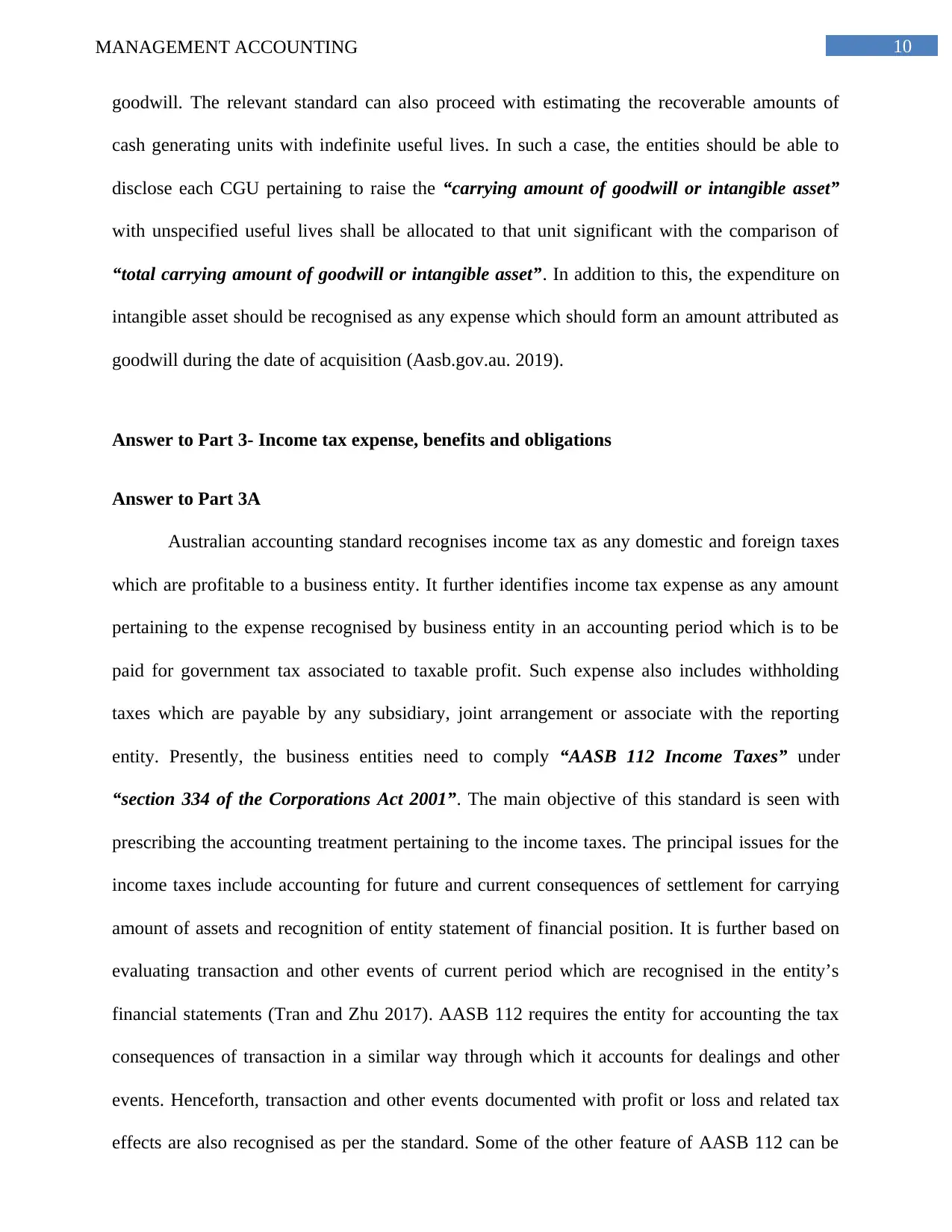
10MANAGEMENT ACCOUNTING
goodwill. The relevant standard can also proceed with estimating the recoverable amounts of
cash generating units with indefinite useful lives. In such a case, the entities should be able to
disclose each CGU pertaining to raise the “carrying amount of goodwill or intangible asset”
with unspecified useful lives shall be allocated to that unit significant with the comparison of
“total carrying amount of goodwill or intangible asset”. In addition to this, the expenditure on
intangible asset should be recognised as any expense which should form an amount attributed as
goodwill during the date of acquisition (Aasb.gov.au. 2019).
Answer to Part 3- Income tax expense, benefits and obligations
Answer to Part 3A
Australian accounting standard recognises income tax as any domestic and foreign taxes
which are profitable to a business entity. It further identifies income tax expense as any amount
pertaining to the expense recognised by business entity in an accounting period which is to be
paid for government tax associated to taxable profit. Such expense also includes withholding
taxes which are payable by any subsidiary, joint arrangement or associate with the reporting
entity. Presently, the business entities need to comply “AASB 112 Income Taxes” under
“section 334 of the Corporations Act 2001”. The main objective of this standard is seen with
prescribing the accounting treatment pertaining to the income taxes. The principal issues for the
income taxes include accounting for future and current consequences of settlement for carrying
amount of assets and recognition of entity statement of financial position. It is further based on
evaluating transaction and other events of current period which are recognised in the entity’s
financial statements (Tran and Zhu 2017). AASB 112 requires the entity for accounting the tax
consequences of transaction in a similar way through which it accounts for dealings and other
events. Henceforth, transaction and other events documented with profit or loss and related tax
effects are also recognised as per the standard. Some of the other feature of AASB 112 can be
goodwill. The relevant standard can also proceed with estimating the recoverable amounts of
cash generating units with indefinite useful lives. In such a case, the entities should be able to
disclose each CGU pertaining to raise the “carrying amount of goodwill or intangible asset”
with unspecified useful lives shall be allocated to that unit significant with the comparison of
“total carrying amount of goodwill or intangible asset”. In addition to this, the expenditure on
intangible asset should be recognised as any expense which should form an amount attributed as
goodwill during the date of acquisition (Aasb.gov.au. 2019).
Answer to Part 3- Income tax expense, benefits and obligations
Answer to Part 3A
Australian accounting standard recognises income tax as any domestic and foreign taxes
which are profitable to a business entity. It further identifies income tax expense as any amount
pertaining to the expense recognised by business entity in an accounting period which is to be
paid for government tax associated to taxable profit. Such expense also includes withholding
taxes which are payable by any subsidiary, joint arrangement or associate with the reporting
entity. Presently, the business entities need to comply “AASB 112 Income Taxes” under
“section 334 of the Corporations Act 2001”. The main objective of this standard is seen with
prescribing the accounting treatment pertaining to the income taxes. The principal issues for the
income taxes include accounting for future and current consequences of settlement for carrying
amount of assets and recognition of entity statement of financial position. It is further based on
evaluating transaction and other events of current period which are recognised in the entity’s
financial statements (Tran and Zhu 2017). AASB 112 requires the entity for accounting the tax
consequences of transaction in a similar way through which it accounts for dealings and other
events. Henceforth, transaction and other events documented with profit or loss and related tax
effects are also recognised as per the standard. Some of the other feature of AASB 112 can be
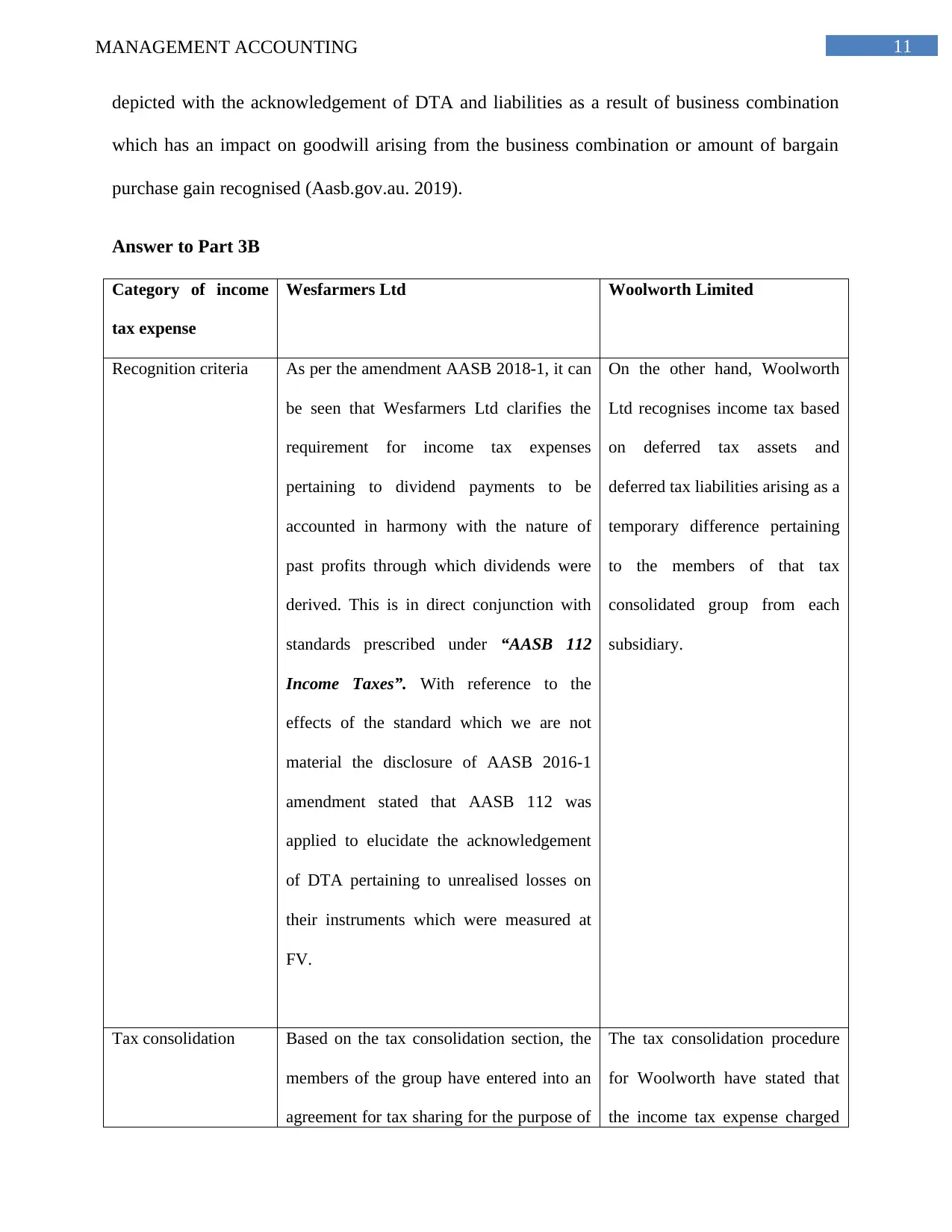
11MANAGEMENT ACCOUNTING
depicted with the acknowledgement of DTA and liabilities as a result of business combination
which has an impact on goodwill arising from the business combination or amount of bargain
purchase gain recognised (Aasb.gov.au. 2019).
Answer to Part 3B
Category of income
tax expense
Wesfarmers Ltd Woolworth Limited
Recognition criteria As per the amendment AASB 2018-1, it can
be seen that Wesfarmers Ltd clarifies the
requirement for income tax expenses
pertaining to dividend payments to be
accounted in harmony with the nature of
past profits through which dividends were
derived. This is in direct conjunction with
standards prescribed under “AASB 112
Income Taxes”. With reference to the
effects of the standard which we are not
material the disclosure of AASB 2016-1
amendment stated that AASB 112 was
applied to elucidate the acknowledgement
of DTA pertaining to unrealised losses on
their instruments which were measured at
FV.
On the other hand, Woolworth
Ltd recognises income tax based
on deferred tax assets and
deferred tax liabilities arising as a
temporary difference pertaining
to the members of that tax
consolidated group from each
subsidiary.
Tax consolidation Based on the tax consolidation section, the
members of the group have entered into an
agreement for tax sharing for the purpose of
The tax consolidation procedure
for Woolworth have stated that
the income tax expense charged
depicted with the acknowledgement of DTA and liabilities as a result of business combination
which has an impact on goodwill arising from the business combination or amount of bargain
purchase gain recognised (Aasb.gov.au. 2019).
Answer to Part 3B
Category of income
tax expense
Wesfarmers Ltd Woolworth Limited
Recognition criteria As per the amendment AASB 2018-1, it can
be seen that Wesfarmers Ltd clarifies the
requirement for income tax expenses
pertaining to dividend payments to be
accounted in harmony with the nature of
past profits through which dividends were
derived. This is in direct conjunction with
standards prescribed under “AASB 112
Income Taxes”. With reference to the
effects of the standard which we are not
material the disclosure of AASB 2016-1
amendment stated that AASB 112 was
applied to elucidate the acknowledgement
of DTA pertaining to unrealised losses on
their instruments which were measured at
FV.
On the other hand, Woolworth
Ltd recognises income tax based
on deferred tax assets and
deferred tax liabilities arising as a
temporary difference pertaining
to the members of that tax
consolidated group from each
subsidiary.
Tax consolidation Based on the tax consolidation section, the
members of the group have entered into an
agreement for tax sharing for the purpose of
The tax consolidation procedure
for Woolworth have stated that
the income tax expense charged
⊘ This is a preview!⊘
Do you want full access?
Subscribe today to unlock all pages.

Trusted by 1+ million students worldwide
1 out of 19
Related Documents
Your All-in-One AI-Powered Toolkit for Academic Success.
+13062052269
info@desklib.com
Available 24*7 on WhatsApp / Email
![[object Object]](/_next/static/media/star-bottom.7253800d.svg)
Unlock your academic potential
Copyright © 2020–2025 A2Z Services. All Rights Reserved. Developed and managed by ZUCOL.





